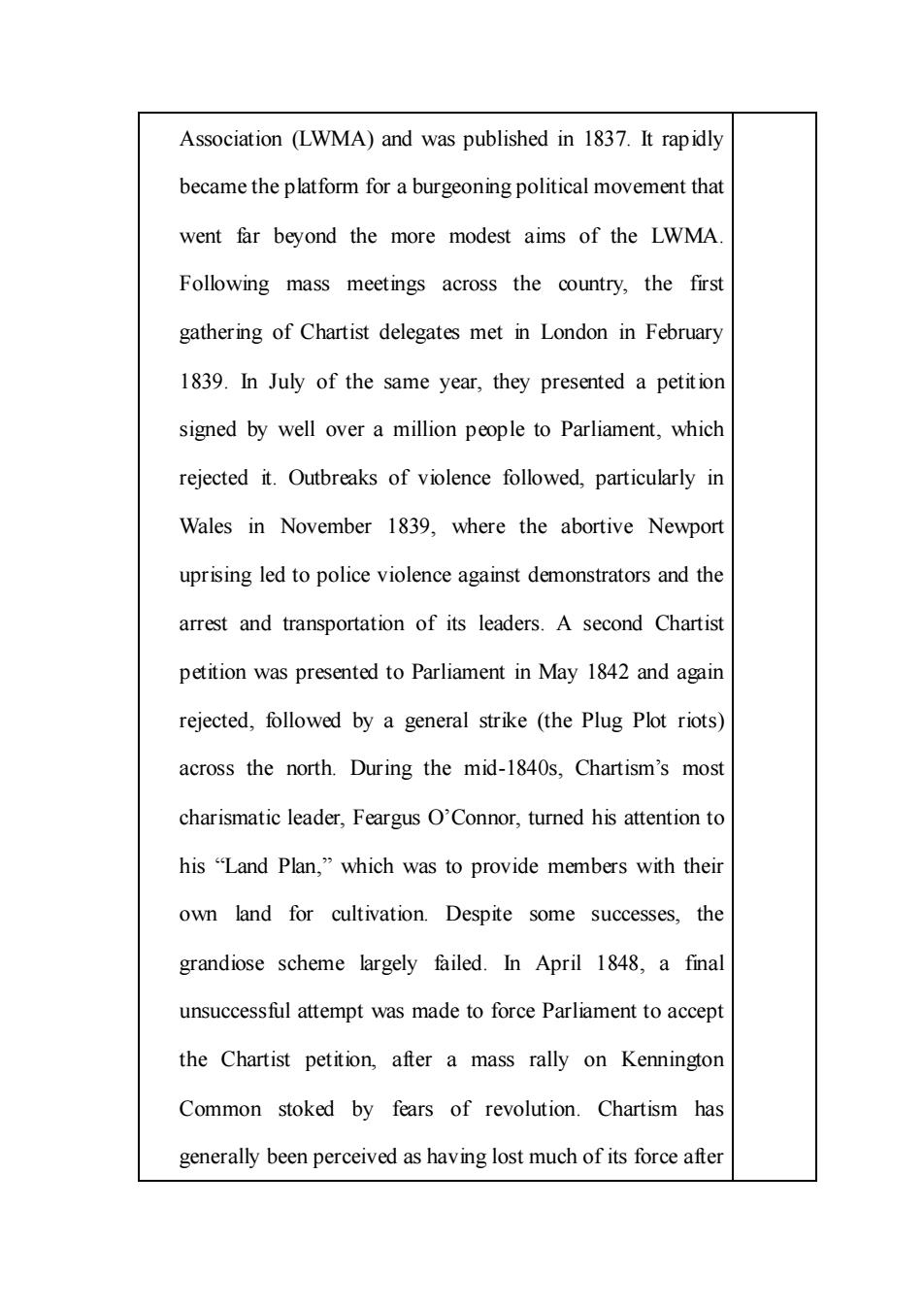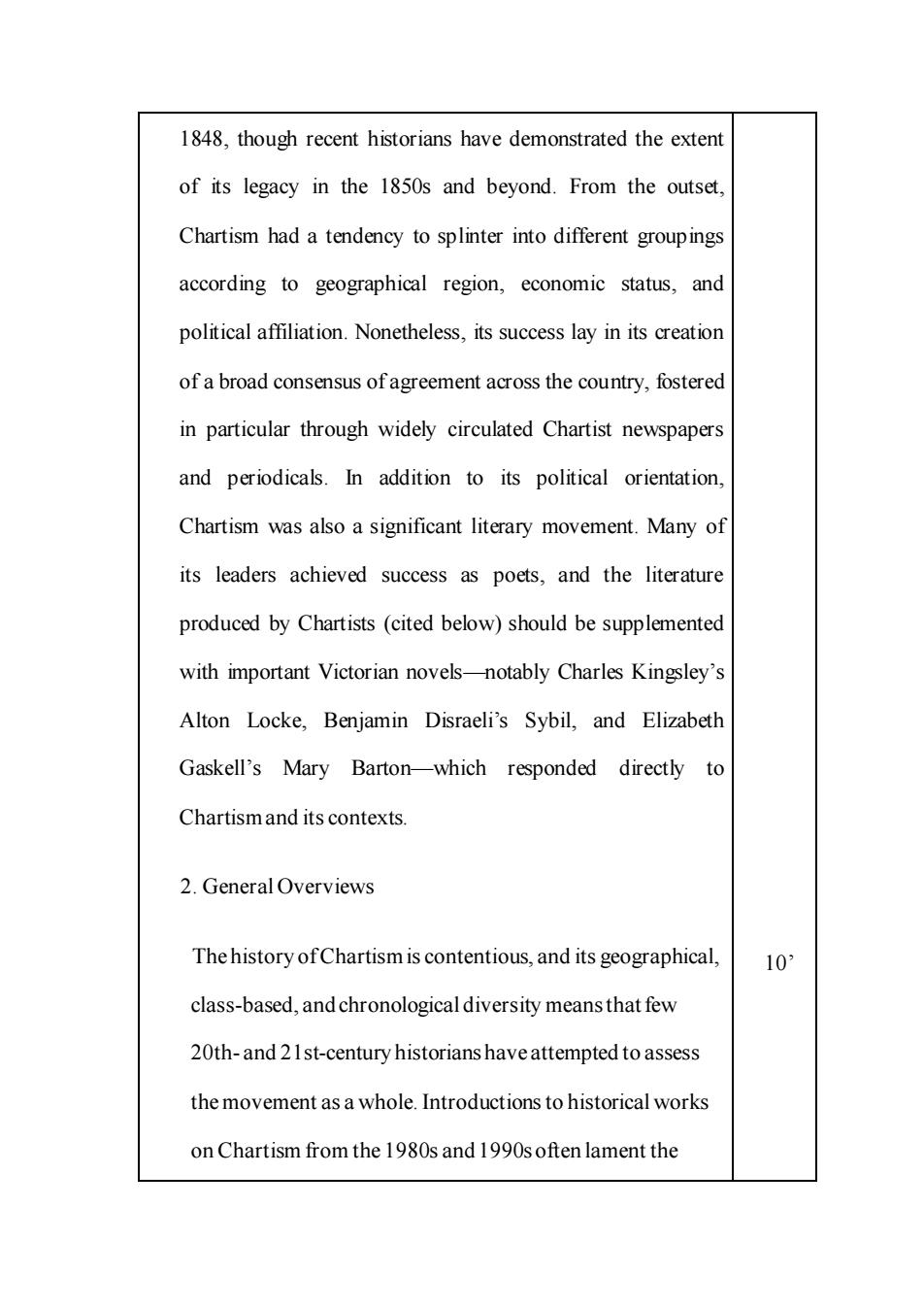
anthropology drastically changed people's life -German philosophers such as Ludwig Feuerbach and Comte exerted great influences over British ideological field. -Darwin's Origin of Species (1859)and The Descent of Man (1871)shook the theoretical basis of the conventional religious faith. The Problem of Women -In 1837 when Queen Victoria came to the throne,married women had no property rights,not even in the proceeds of their ⊙ own earnings.They had no rights to custody of their own children and were excluded from universities and professions. -In this period,sexual inequality in politics,economic life. education and social positions still prevailed;women were still regarded as second-class citizens. -The explosive growth of industry,especially the textile industry,brought hundreds of thousands of women into factory jobs. -In factories,women were employed as cheap labor and were forced to do very heavy and hard jobs for about half the usual pay.The unbearable working conditions and unemployment drove thousands of women into prostitution. -Factory work presented an increasing challenge to the
anthropology drastically changed people’s life. - German philosophers such as Ludwig Feuerbach and Comte exerted great influences over British ideological field. - Darwin’s Origin of Species (1859) and The Descent of Man (1871) shook the theoretical basis of the conventional religious faith. The Problem of Women - In 1837 when Queen Victoria came to the throne, married women had no property rights, not even in the proceeds of their own earnings. They had no rights to custody of their own children and were excluded from universities and professions. - In this period, sexual inequality in politics, economic life, education and social positions still prevailed; women were still regarded as second-class citizens. - The explosive growth of industry, especially the textile industry, brought hundreds of thousands of women into factory jobs. - In factories, women were employed as cheap labor and were forced to do very heavy and hard jobs for about half the usual pay. The unbearable working conditions and unemployment drove thousands of women into prostitution. - Factory work presented an increasing challenge to the 10’

conventional ideas of women and opened up new and wide spheres for women. -Women now were able to walk out of the home,to share part of the responsibility of men and help support the family,and,at the same time,were entering into social services. -A feminist movement started,fighting for women's equality and freedom,and for their educational and employment opportunities. III.Victorian Literature:Mainly three kinds: the Chartist literature English Critical Realism 5 Victorianpoetry IV.Chartist Literature 1.Introduction Chartism was a national political movement,associated with working-class radicalism,with the avowed goal of forcing the British parliament to accept the"Six Points"of the People's 10 Charter:a vote for every man over 21,secret ballots,no property qualification for MPs,salaries for MPs,equal constituencies,and annual parliaments.All of these demands except the last would be met within a century.The People's Charter originated from the London Working Men's
conventional ideas of women and opened up new and wide spheres for women. - Women now were able to walk out of the home, to share part of the responsibility of men and help support the family, and, at the same time, were entering into social services. - A feminist movement started, fighting for women’s equality and freedom, and for their educational and employment opportunities. III. Victorian Literature: Mainly three kinds: the Chartist literature English Critical Realism Victorian poetry IV. Chartist Literature 1. Introduction Chartism was a national political movement, associated with working-class radicalism, with the avowed goal of forcing the British parliament to accept the “Six Points” of the People’s Charter: a vote for every man over 21, secret ballots, no property qualification for MPs, salaries for MPs, equal constituencies, and annual parliaments. All of these demands except the last would be met within a century. The People’s Charter originated from the London Working Men’s 5’ 10’

Association (LWMA)and was published in 1837.It rapidly became the platform for a burgeoning political movement that went far beyond the more modest aims of the LWMA Following mass meetings across the country,the firs gathering of Chartist delegates met in London in February 1839.In July of the same year,they presented a petition signed by well over a million people to Parliament,which rejected it.Outbreaks of violence followed,particularly in Wales in November 1839,where the abortive Newport uprising led to police violence against demonstrators and the arrest and transportation of its leaders.A second Chartist petition was presented to Parliament in May 1842 and again rejected,followed by a general strike (the Plug Plot riots) across the north.During the mid-1840s,Chartism's most charismatic leader,Feargus O'Connor,turned his attention to his "Land Plan,"which was to provide members with their own land for cultivation.Despite some successes,the grandiose scheme largely failed.In April 1848,a final unsuccessful attempt was made to force Parliament to accept the Chartist petition,after a mass rally on Kennington Common stoked by fears of revolution.Chartism has generally been perceived as having lost much of its force after
Association (LWMA) and was published in 1837. It rapidly became the platform for a burgeoning political movement that went far beyond the more modest aims of the LWMA. Following mass meetings across the country, the first gathering of Chartist delegates met in London in February 1839. In July of the same year, they presented a petition signed by well over a million people to Parliament, which rejected it. Outbreaks of violence followed, particularly in Wales in November 1839, where the abortive Newport uprising led to police violence against demonstrators and the arrest and transportation of its leaders. A second Chartist petition was presented to Parliament in May 1842 and again rejected, followed by a general strike (the Plug Plot riots) across the north. During the mid-1840s, Chartism’s most charismatic leader, Feargus O’Connor, turned his attention to his “Land Plan,” which was to provide members with their own land for cultivation. Despite some successes, the grandiose scheme largely failed. In April 1848, a final unsuccessful attempt was made to force Parliament to accept the Chartist petition, after a mass rally on Kennington Common stoked by fears of revolution. Chartism has generally been perceived as having lost much of its force after

1848,though recent historians have demonstrated the extent of its legacy in the 1850s and beyond.From the outset, Chartism had a tendency to splinter into different groupings according to geographical region,economic status,and political affiliation.Nonetheless,its success lay in its creation of a broad consensus ofagreement across the country,fostered in particular through widely circulated Chartist newspapers and periodicals.In addition to its political orientation, Chartism was also a significant literary movement.Many of its leaders achieved success as poets,and the literature produced by Chartists (cited below)should be supplemented with important Victorian novels-notably Charles Kingsley's Alton Locke,Benjamin Disraeli's Sybil,and Elizabeth Gaskell's Mary Barton-which responded directly to Chartismand its contexts 2.GeneralOverviews The history ofChartism is contentious,and its geographical, 10 class-based,andchronological diversity meansthat few 20th-and 21st-century historianshaveattempted to assess the movement as a whole.Introductions to historical works on Chartism from the 1980s and 1990s often lament the
1848, though recent historians have demonstrated the extent of its legacy in the 1850s and beyond. From the outset, Chartism had a tendency to splinter into different groupings according to geographical region, economic status, and political affiliation. Nonetheless, its success lay in its creation of a broad consensus of agreement across the country, fostered in particular through widely circulated Chartist newspapers and periodicals. In addition to its political orientation, Chartism was also a significant literary movement. Many of its leaders achieved success as poets, and the literature produced by Chartists (cited below) should be supplemented with important Victorian novels—notably Charles Kingsley’s Alton Locke, Benjamin Disraeli’s Sybil, and Elizabeth Gaskell’s Mary Barton—which responded directly to Chartism and its contexts. 2. General Overviews The history of Chartism is contentious, and its geographical, class-based, and chronological diversity means that few 20th- and 21st-century historians have attempted to assess the movement as a whole. Introductions to historical works on Chartism from the 1980s and 1990s often lament the 10’